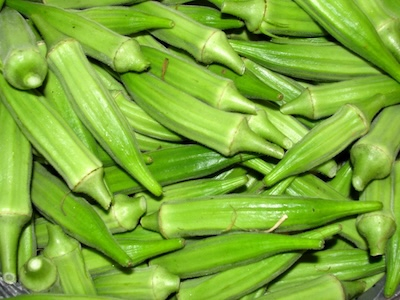
Okra is a staple backyard garden crop in the South.
June 2, 2024 - I am a little late getting my okra planted this year but there is still time. I will plant it where I recently dug my Irish potatoes. Okra is synonymous with Southern culture. The African name for okra was gumbo and subsequently gave us the name for the popular Creole soup. I grew up with okra and like it raw, boiled, roasted, grilled, fried, stewed, and certainly in gumbo. Lots of folks that do not like okra will eat it sprinkled with olive oil, seasoned salt, sea salt, or Tony Chachere’s, and roasted in the oven at 400 degrees. Fried was my favorite growing up, because my mother could fry a shoe and make it taste good.
Okra is a warm season plant that cannot tolerate frosts, freezes, or even cool nights. It thrives on heat so should be planted well after the last frost each year, generally April-May in East Texas, but as late as July 4. Okra is easily planted from seed. Soak it in warm water over night to speed up the germination process. Once the seedlings are established and about 6 inches tall, thin them to 12-18 inches apart. Occasionally okra transplants are available which can be planted at the same spacing.
Okra needs at least 8 hours of direct sun each day for maximum production. It is not fussy about soils if they drain well. Due to a susceptibility to root knot nematodes, it is best to avoid areas where this has been a problem in the past or where okra was planted the previous year. It is ideal to till in several inches of compost or organic matter and incorporate 2 pounds of a complete lawn fertilizer (15-5-10, etc.) per 100 square foot of bed or every 35 feet of row before planting. For small plantings use 2 teaspoons per square foot or foot of row. Organic fertilizers will do the trick as well, but you have to use more to get the same amount of nutrients. The ideal soil pH for growing okra is 6.0-7.0.
Okra can be planted on flat ground, in raised beds, or rows. The rows should be 6-8 inches high, 24 inches wide, and 36-48 inches apart. Using the corner of a hoe or a stick, open a trench ½-3/4 inch deep and plant the okra seed at a rate of 4-5 per foot of row. Cover the seed lightly with well cultivated soil and gently tamp down with the back of the hoe to conserve moisture and ensure good seed to soil contact.
Okra is easy to grow and relatively pest-free, however there are a few potential problems including nematodes and fire ants. First ants can inflict damage to the blooms, young pods, and your hands. Treat the base of the plants and the mounds with an appropriately labeled pesticide when they occur. After thinning, lightly sidedress them with a high nitrogen fertilizer, such as 21-0-0. I often use aged chicken litter from my flock.
Okra pods should be harvested when they are 3-5 inches long and tender. Sometimes they will snap from the plant, but I usually use a pair of hand pruners. Okra foliage irritates some gardener’s skin, including mine, so you might want to wear a long sleeve shirt. Okra needs to be harvested every other day to keep producing well. If the pods are left on the plant until they get tough and the seeds plump up, the entire plant will stop producing. Consider leaving a few plants for the pods to dry and turn brown for next year’s seed.
All okra varieties do well in East Texas. When the plants get too tall to pick, I cut the top of the middle stalk which makes the plant branch from below at lower heights and increases production. Okra is native to Africa.
Greg Grant is the Smith County horticulturist and Master Gardener coordinator for the Texas A&M AgriLife Extension Service. He is the author of Texas Fruit and Vegetable Gardening, Texas Home Landscaping, Heirloom Gardening in the South, and The Rose Rustlers. You can read his “Greg’s Ramblings” blog at arborgate.com, read his “In Greg’s Garden” in each issue of Texas Gardener magazine (texasgardener.com), or follow him on Facebook at “Greg Grant Gardens.” More science-based lawn and gardening information from the Texas A&M AgriLife Extension Service can be found at aggieturf.tamu.edu and aggie-horticulture.tamu.edu.








